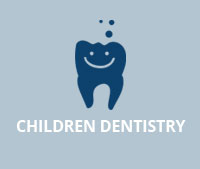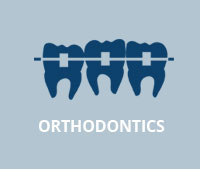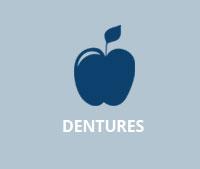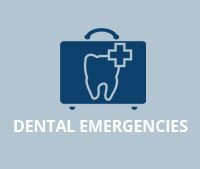
Treatments & Services
Most of us are familiar with dental treatments such as fillings, root canals, crowns, bridges and dentures. But how much do you really know about these treatments? This section provides a wealth of information on a wide variety of dental treatments offered by Amherstburg Dental
Braces
 Early identification of dental or skeletal crowding or misalignment is essential to a successful orthodontic program. When you have your check-up and cleaning we identify potential problems that may exist that would interfere with proper tooth alignment, function, and esthetics as your child grows. By identifying problems at the correct time and utilizing children’s own growth patterns, early intervention can be taken. This is the key that can greatly reduce both the cost and treatment time in braces.
Early identification of dental or skeletal crowding or misalignment is essential to a successful orthodontic program. When you have your check-up and cleaning we identify potential problems that may exist that would interfere with proper tooth alignment, function, and esthetics as your child grows. By identifying problems at the correct time and utilizing children’s own growth patterns, early intervention can be taken. This is the key that can greatly reduce both the cost and treatment time in braces.
At Amherstburg Dental, Dr. Zeljko Veselinovic and Dr. Jerri Ann Buxton believe patients should understand their options before committing to orthodontic treatment. Is now the right time for your child to get braces? Are InvisAlign braces a good option for teens and adults? What types of braces will get you the best results? We offer a detailed Orthodontic Evaluation (Braces Exam) when you schedule this type of examination with our dentists. In addition, we also offer Invisilign Braces for children and adult patients to be able to straighten most minor to moderate misalignments.
Dr. Jerri Ann Buxton has achieved InvisAlign Preferred Provider status. The average dentist may perform the occasional InvisAlign procedure. Dr. Jerri Ann Buxton has successfully and routinely treated to completion more InvisAlign orthodontic cases than the average dentist by the InvisAlign Company’s definition. Experience counts.
Also, if we have identified more complicated treatments, we will arrange an appointment for an orthodontist, or a qualified specialist for braces, who can develop and identify a treatment outcome for long term success. We have established great working relationships with some of the foremost orthodontic specialists in our area. Several of whom lecture throughout North America and abroad in their fields. The specialists we use teach other specialists. After our office identifies a potential orthodontic problem that we cannot treat in general practice, our dental team may make a referral to a qualified orthodontist who matches your goals and demeanor.
If you are not sure about if crowding will go away, why adult teeth are erupting behind baby teeth, tired of your dentist just telling you nothing about braces, or just wish to have your child looked at for braces, then please call us at your earliest convenience at (519) 736-4073.
Checkups & Cleanings
 Preventive Dental Cleaning is the foundation of all good oral health. Amherstburg Dental Family Dentistry offers flexible office hours and appointment times including evenings and saturdays to help accomodate busy families to attend their cleanings. Our friendly staff will make sure that you are contacted as a reminder to schedule your check-ups and cleanings. We will work within your benefit plan to arrange for extra cleanings for you if needed. Also, we will work with your insurance company to bill them directly for rendered services whenever possible. Our treatment coordinators will be happy to help you look into your coverage with your permission to maximize your coverage.
Preventive Dental Cleaning is the foundation of all good oral health. Amherstburg Dental Family Dentistry offers flexible office hours and appointment times including evenings and saturdays to help accomodate busy families to attend their cleanings. Our friendly staff will make sure that you are contacted as a reminder to schedule your check-ups and cleanings. We will work within your benefit plan to arrange for extra cleanings for you if needed. Also, we will work with your insurance company to bill them directly for rendered services whenever possible. Our treatment coordinators will be happy to help you look into your coverage with your permission to maximize your coverage.
Call our office at (519) 736-4073 to schedule your cleanings with us today.
Crowns & Bridges
 What is a Crown? A crown is a cap or cover for a tooth that looks exactly like a natural tooth. When a tooth becomes damaged or is susceptible to fracture, a crown may be needed. As a good general rule, if a tooth has a white or silver filling in it that is greater than 1/3rd of the width of the tooth, then the tooth may be more susceptible to fracture and may benefit from strengthening it with a crown. In addition, crowns are placed to enhance the appearance of teeth for cosmetic reasons. Traditionally crowns were made of Gold, Silver, and/or other alloys. As there became a need for more esthetically pleasing crowns, the use of porcelain baked onto a metal substructure became a much more popular option. Today most crowns are made entirely of porcelain either by hand and/or help from a computer.
What is a Crown? A crown is a cap or cover for a tooth that looks exactly like a natural tooth. When a tooth becomes damaged or is susceptible to fracture, a crown may be needed. As a good general rule, if a tooth has a white or silver filling in it that is greater than 1/3rd of the width of the tooth, then the tooth may be more susceptible to fracture and may benefit from strengthening it with a crown. In addition, crowns are placed to enhance the appearance of teeth for cosmetic reasons. Traditionally crowns were made of Gold, Silver, and/or other alloys. As there became a need for more esthetically pleasing crowns, the use of porcelain baked onto a metal substructure became a much more popular option. Today most crowns are made entirely of porcelain either by hand and/or help from a computer.
Generally, a crown is placed on a tooth by preparing the tooth for a crown. Above the gum line, the tooth is reduced slightly all the way around and on the biting surface to make room for the porcelain. A model is made with a silicone impression and sent to the laboratory for fabrication. Moreover, the patient does not leave with a shaved smaller tooth. Instead a temporary plastic crown is made by the dentist and placed on the tooth while the permanent crown is being made at the lab. After the permanent crown is returned from the lab, the crown is tried on to see if it fits and looks good. Then the new porcelain crown is cemented permanently. As long as the patient cares for the new tooth properly with daily brushing and flossing, the crown should last for many years. It is not uncommon to see patients with crowns that are at least 20 to 30 years old and still maintaining very well both in fuction and appearance. Generally, a crown should only need to be done once in a lifetime.
What is a Bridge? A bridge is just an extension of several crowns put together. A bridge is used to ‘bridge a gap’. Untimely tooth loss resulting in large spaces between teeth can be filled with a bridge. A crown is placed on each of the teeth next to the space and a floating crown (called a pontic) that sits on the gums is bonded between the two crowns. So a bridge is made up of three parts, two abutments and one pontic. Thinking of a real life bridge, it has two supports and a span. The bridge is made at the lab from porcelain and arrives to be cemented as one piece that looks like three teeth stuck together. Larger bridges can be made, but the amount of biting force and patient’s eating mechanics have to be considered first. If a larger bridge becomes a poor choice for restoration because of space limitations, then implants may become better alternatives.
Services we offer: In partenership with our dental laboratories we offer the latest in porcelain crowns and bridges. The tooth models are computer scanned and fabricated with a CAD/CAM (Computer-Aided Design and Computer-Aided Manufacturing) system that precisely mills the crowns and bridges to exacting specifications. This means that every crown and bridge is custom made for you. The dental lab technicians put on the final touches to each crown and every restoration is inspected by our dentists for esthetics, quality, and fit before the patient returns for the delivery appointment. We can also arrange a tooth color or shade matching appointment with our partners at the dental lab to make sure the tooth color of your crown or bridge matches perfectly. No one should be able to tell where your crown ends or the tooth starts, it should blend in that well.
Dental Emergencies
 What is a dental emergency? It is any problem that anyone thinks needs immediate attention. It’s that simple. If I can help you with a problem, whether it is minuscule or major, don’t hesitate or be embarrassed to call our office right away. I often hear from patients that “I didn’t want to bother you with it” or “I didn’t want to waste your time”. I am here to help out and it is my job and my pleasure to help out. Call me!
What is a dental emergency? It is any problem that anyone thinks needs immediate attention. It’s that simple. If I can help you with a problem, whether it is minuscule or major, don’t hesitate or be embarrassed to call our office right away. I often hear from patients that “I didn’t want to bother you with it” or “I didn’t want to waste your time”. I am here to help out and it is my job and my pleasure to help out. Call me!
If you think you are having a dental emergency, them please call our office immediately. We will try our best to accommodate you the same day. The earlier you call in the day, the easier we can accommodate you.
What happens if my emergency is after hours? Then you have several options. Please call and leave a message on our general office voicemail at 519 736-4073. We will call you right away when the office opens in the morning. If you feel that your emergency can’t wait until the morning, then please leave us a message on our after hours dentist’s personal voicemail (Dr. Zeljko’s is 519 980-4073). The numbers are provided in this website and on our general voicemail message. We will call you back as soon as possible. Trust me when I say that all our dentist’s love their mobile phones and don’t part from them for long. We will get your message fast. Please call us.
Some patient’s ask….Are you just going to see me and then ship me off to some specialist? NO! Most of our emergencies can be managed and treated in our office by Dr. Zeljko or one of our skilled associate dentists. We often make referrals between team dentists, with the patient’s permission, within our own office .However, if there is a problem that is beyond what we can do in the office, it may require the services of a specialist. If so then we will personally help arrange that you are seen quickly by one of the specialists that we work with. We have established a wonderful working relationship with every specialist we refer to. They know if our staff calls, then we have a true emergency that requires immediate attention by the specialist.
You are not going to be good to anyone when you are in pain. Not to your family. Not to your employer. You can’t concentrate on work when you are in pain. Don’t ignore it. Get help. We hope this information has been valuable.
Services we offer: We offer same day emergency appointments during regular business hours and we try to be as accomodating as possible. After hours emergencies are seen as soon as we can and definitely by the next business day morning. Remember we are open six days a week for your convenience.
Please don’t be afraid or embarrassed to call us immediately at 519 736-4073 if you have an emergency. We are here to help.
Dental Implants
 An implant is a post right? No an implant is not a post, it is a titanium pin or peg that is usually threaded or seated into the jawbone to replace a lost tooth. Once the implant grows bone around it, a process called osseointegration, the implant can be treated like a regular tooth at which point a crown can be fitted onto the implant. It is generally a painless procedure. The bone into which the implant is placed does not have any sensory nerves, only the covering soft tissue does. So the entire procedure can be done with local anesthetic or “freezing” if that is preferable to the patient. It takes about 2 to 3 months for the bone to grow around the implant. The implant is then uncovered to create a collar of gum tissue around the implant by placing a healing abutment. just like around a natural tooth. The healing abutment looks like a tiny manhole cover. After 2 weeks after healing abutment placment, the dentist can begin the final prosthetic phase. A ccustomized crown abutment is attached to the healed implant and a crown or bridge is then bonded to the implant abutment itself. Modern implants are very successful, very simple to place, and are placed regularly in our office. The greatest limiting factor to implant success is smoking and gum disease. Only a dentist can assess if these factors will be problematic to the placing and success of your implants. The advantage of implants to replace lost teeth is that neighboring teeth next to a space would have had to be altered to prepare a conventional bridge. With implants adjacent teeth are left alone and good tooth structure is conserved.
An implant is a post right? No an implant is not a post, it is a titanium pin or peg that is usually threaded or seated into the jawbone to replace a lost tooth. Once the implant grows bone around it, a process called osseointegration, the implant can be treated like a regular tooth at which point a crown can be fitted onto the implant. It is generally a painless procedure. The bone into which the implant is placed does not have any sensory nerves, only the covering soft tissue does. So the entire procedure can be done with local anesthetic or “freezing” if that is preferable to the patient. It takes about 2 to 3 months for the bone to grow around the implant. The implant is then uncovered to create a collar of gum tissue around the implant by placing a healing abutment. just like around a natural tooth. The healing abutment looks like a tiny manhole cover. After 2 weeks after healing abutment placment, the dentist can begin the final prosthetic phase. A ccustomized crown abutment is attached to the healed implant and a crown or bridge is then bonded to the implant abutment itself. Modern implants are very successful, very simple to place, and are placed regularly in our office. The greatest limiting factor to implant success is smoking and gum disease. Only a dentist can assess if these factors will be problematic to the placing and success of your implants. The advantage of implants to replace lost teeth is that neighboring teeth next to a space would have had to be altered to prepare a conventional bridge. With implants adjacent teeth are left alone and good tooth structure is conserved.
Services we offer: We plan and complete a wide range of dental implant systems and solutions that replaces one tooth, several teeth, or full upper and/or lower fixed teeth as large bridged sections. We also offer full reconstruction and treatment planning of large areas of lost teeth or collapsed bites.
Dentures
 What are dentures? A denture is a removable replacement for missing teeth and adjacent tissues. A complete denture is solely made of acrylic resin and teeth. A partial denture is made of similar materials that are bonded to a metal framework. Complete dentures replace all the teeth, while a partial dentures fill in the spaces where there are missing teeth. The premature loss of teeth can cause the adjacent teeth to collapse into the space both next to and above the space of the missing tooth (teeth). In the long run, teeth shift and become malpositioned and the jaw joint attempts to compensate for the missing teeth by shifting also. So not only do lost teeth mess-up the arrangement of the teeth, but the jaw joint itself. pain and discomfort can result from a mal-positioned jaw joint. It is not a question of if this phenomenon occurs but when this combination of effects occurs. Dentures can correct and prevent this combination syndrome from occurring by maintaining the other teeth from changing position.
What are dentures? A denture is a removable replacement for missing teeth and adjacent tissues. A complete denture is solely made of acrylic resin and teeth. A partial denture is made of similar materials that are bonded to a metal framework. Complete dentures replace all the teeth, while a partial dentures fill in the spaces where there are missing teeth. The premature loss of teeth can cause the adjacent teeth to collapse into the space both next to and above the space of the missing tooth (teeth). In the long run, teeth shift and become malpositioned and the jaw joint attempts to compensate for the missing teeth by shifting also. So not only do lost teeth mess-up the arrangement of the teeth, but the jaw joint itself. pain and discomfort can result from a mal-positioned jaw joint. It is not a question of if this phenomenon occurs but when this combination of effects occurs. Dentures can correct and prevent this combination syndrome from occurring by maintaining the other teeth from changing position.
Complete dentures are categorized as either conventional or immediate. A conventional denture is placed in the mouth about 6-8 weeks after all the teeth are removed to allow for proper healing of the tissues. The inside of the denture conforms to the tissue side of the jaw and if fabrication of the denture was made prior to healing, then it would result in an ill-fitting prosthesis. By comparison, an immediate denture is placed as soon as the teeth are removed. For the next 3 to 6 months constant relines are required with tissue conditioner as the gums shrink as they heal. When the gums are fully healed, then a permanent reline can be done to finalize the denture. The benefits of an immediate denture is the patient never goes without their teeth except overnight for a permanent reline.
Even if you have been wearing complete dentures for years, it is important to continue having regular dental checkups so that a dentist can examine oral tissues for signs of disease or cancer. As a result of aging, your mouth will continue to change as the bone under your denture shrinks or recedes. To maintain a proper fit over time, it may be necessary to adjust your dentures, reline your dentures, or possibly remake your dentures. Denture generally last 5 to 10 years after which time teeth may have flattened on them to the point where replacement is needed. Never attempt to adjust a denture yourself, leave it to the professionals. many of our handy patients have dremel tools at home and may attempt to adjust sore spots themselves. Attempting to do so may result in the removal of areas of the denture that aids in it’s retention and make the denture less useful. Again, please feel free to make an appointment and consult with our dental office if you have any questions about your dentures.
Patients who suffer from severe bone loss, also called atrophy, from years of wearing dentures have a difficuly time keeping their dentures in their mouths and would greatly benefit from implant supported dentures. Please read the implant section for specific information regarding implants. For ill-fitting lower dentures, the contemporary solution would involve the placement of two or more titanium implants in the front area and middle areas of the lower jaw. This would not only provide a stable foundation for a new denture prosthesis, but also serve the secondary purpose of halting any further atrophy of the lower jaw. Approximately two weeks following the dental implant placement, the patient is seen for a generous alteration of the bottom denture including grinding out the denture bearing surface and placing a thick soft reline over the surgical site. Three months following the placement of the implants, the implants are exposed and healing abutments are placed. Also, a reline of the denture over the healing abutments is done. Within two to three weeks of abutment placement, the final prosthetic phase can begin. Dentures are usally supported by ball and O-rings or a bar and clips. These are integrated onto the implants and dentures so there is a secure fit between them. A similar process is performed for upper dentures. All of these solutions are removable. If a fixed solution that does not get removed is something that is more desirable, please read the implant section.
Services we offer: All of our dentures are fabricated with our partners at our dental lab. They are NOT denturists, but certified dental technicians. It takes several appointments by our dentists to properly fit you with the right denture and guide the fabrication process at the lab. After delivery of the dentures, follow-up appointments are necessary, expected, and included to adjust any sore-spots that develop in the weeks following completion. We believe that a one-time visit to a denturist is not an acceptable method for making dentures nor should you accept that this is the standard of care. Explore your options, we can help you!
Periodontal (Gums)
 Understanding Gum Disease: Gingivitis is bleeding gums. Bleeding gums by itself is not a bad thing but can be an indicator of your gum’s health. One of the only ways that the body knows how to defend itself is by bleeding and swelling. When food and bacteria gets stuck between teeth, the body responds to this by trying to flush out the area. The only way is knows how is by bleeding. In blood there are mostly red and white blood cells. The white blood cells try to eat the bacteria and other foreign matter like pac-man. Once they do this the white blood cells themselves die and begin to leak out of the natural pockets between the tooth and the gums. Also, bacteria that set up shop in these areas do not like air. The red blood cells flush out the area by bleeding and carry oxygen with them, which can also kill the bacteria. Once, the gums are mechanically debrided with brushing and flossing, then the gums return to health. This means that gingivitis is 100% reversible. Moreover, flossing your teeth doesn’t make them bleed. Flossing your teeth makes the bleeding go away! Conversely, if gingivitis or bleeding gums are allowed to persist, then the decaying food and bacteria (plaque) can harden into tartar. Long standing tartar and persistent gingivitis can make the body realize that this bleeding and swelling isn’t working. The body’s only choice then is to treat the entire tooth like a foreign object and start to get rid of it. So the bone starts to dissolve from around the teeth. Tooth movement and tooth loss can result. This is now periodontal disease or periodontitis. Periodontitis can be treated so it doesn’t get worse, but the bone that was lost can never grow back. This is why regular visits to the dentist for cleanings and check-ups 2-4 times per year are extremely important. Also, brushing alone cannot keep your teeth clean. Think of the tooth as having five surfaces that can be cleaned. The best brusher in the world can only clean the biting surface, the cheek-side surface, and the tongue-side surface. The toothbrush can’t get in between teeth to clean the front-side surface and back-side surface. Only brushing your teeth alone without flossing results in cleaning 3 out of 5 surfaces. That’s 60% clean! Only flossing can get in between your teeth to fully clean all surfaces. Using a water-jet or water-pik instead of flossing is the same as just watering your lawn but never cutting it. You must mechanically debride all the surfaces of the teeth with brushing AND flossing. Again, some patients complain that their gums bleed when they floss. This is not from flossing, but from food and bacteria stuck between teeth. After a few days of flossing, the bleeding should disappear. If you are unsure about your flossing technique, please feel free to visit us at Amherstburg Dental so we may instruct you on proper flossing technique so you are not harming your gums with the floss.
Understanding Gum Disease: Gingivitis is bleeding gums. Bleeding gums by itself is not a bad thing but can be an indicator of your gum’s health. One of the only ways that the body knows how to defend itself is by bleeding and swelling. When food and bacteria gets stuck between teeth, the body responds to this by trying to flush out the area. The only way is knows how is by bleeding. In blood there are mostly red and white blood cells. The white blood cells try to eat the bacteria and other foreign matter like pac-man. Once they do this the white blood cells themselves die and begin to leak out of the natural pockets between the tooth and the gums. Also, bacteria that set up shop in these areas do not like air. The red blood cells flush out the area by bleeding and carry oxygen with them, which can also kill the bacteria. Once, the gums are mechanically debrided with brushing and flossing, then the gums return to health. This means that gingivitis is 100% reversible. Moreover, flossing your teeth doesn’t make them bleed. Flossing your teeth makes the bleeding go away! Conversely, if gingivitis or bleeding gums are allowed to persist, then the decaying food and bacteria (plaque) can harden into tartar. Long standing tartar and persistent gingivitis can make the body realize that this bleeding and swelling isn’t working. The body’s only choice then is to treat the entire tooth like a foreign object and start to get rid of it. So the bone starts to dissolve from around the teeth. Tooth movement and tooth loss can result. This is now periodontal disease or periodontitis. Periodontitis can be treated so it doesn’t get worse, but the bone that was lost can never grow back. This is why regular visits to the dentist for cleanings and check-ups 2-4 times per year are extremely important. Also, brushing alone cannot keep your teeth clean. Think of the tooth as having five surfaces that can be cleaned. The best brusher in the world can only clean the biting surface, the cheek-side surface, and the tongue-side surface. The toothbrush can’t get in between teeth to clean the front-side surface and back-side surface. Only brushing your teeth alone without flossing results in cleaning 3 out of 5 surfaces. That’s 60% clean! Only flossing can get in between your teeth to fully clean all surfaces. Using a water-jet or water-pik instead of flossing is the same as just watering your lawn but never cutting it. You must mechanically debride all the surfaces of the teeth with brushing AND flossing. Again, some patients complain that their gums bleed when they floss. This is not from flossing, but from food and bacteria stuck between teeth. After a few days of flossing, the bleeding should disappear. If you are unsure about your flossing technique, please feel free to visit us at Amherstburg Dental so we may instruct you on proper flossing technique so you are not harming your gums with the floss.
How long should I be brushing my teeth for? A good general rule is 2-4 minutes for the top teeth and 2-4 minutes for the bottom teeth with a SOFT or VERY SOFT toothbrush. Using a more abrasive toothbrush like a medium or hard may result in premature tooth wear or recession of the gums at the gum line. People who use a medium or hard tooth brush probably don’t brush for more than 30 seconds total. If you take the time to properly brush your teeth for the recommended time with a soft toothbrush, it is the same as brushing hard with a hard toothbrush and gentler to your teeth and gums over time.
Root Canals
 Anatomy of a Tooth: To understand what a root canal is, one needs to understand the basic anatomy of a tooth. A tooth is made up of three basic layers. The outer-most layer which is white and rock hard is the enamel. The middle layer which is not as hard and slightly yellower is the dentin. The inner-most layer which is composed of the blood supply and the nerves of the tooth is called the pulp. For simplicity, the pulp is the nerve of the tooth. The nerve in the root’s canal (or a channel that goes from the top to the tip of the root) is often not wider than the width of a human hair. When a cavity or trauma harms the nerve, pain and swelling begin in the nerve of the tooth. The body recognizes that the nerve is dead or dying. It sends white blood cells to get rid of the nerve and/or foreign matter like bacteria. As the white blood cells eat up the dead tissue like pac-man that was the nerve, they themselves die off and collect as pus in the area. In soft tissue, this wouldn’t be a big deal as a pimple would form and come to a head causing the pus to leak out. But in an hard enclosed area like a tooth, there is no where for this pus infection to go. So pressure builds and pain builds inside the tooth as the pus collects at the base of the tooth as an abscess.
Anatomy of a Tooth: To understand what a root canal is, one needs to understand the basic anatomy of a tooth. A tooth is made up of three basic layers. The outer-most layer which is white and rock hard is the enamel. The middle layer which is not as hard and slightly yellower is the dentin. The inner-most layer which is composed of the blood supply and the nerves of the tooth is called the pulp. For simplicity, the pulp is the nerve of the tooth. The nerve in the root’s canal (or a channel that goes from the top to the tip of the root) is often not wider than the width of a human hair. When a cavity or trauma harms the nerve, pain and swelling begin in the nerve of the tooth. The body recognizes that the nerve is dead or dying. It sends white blood cells to get rid of the nerve and/or foreign matter like bacteria. As the white blood cells eat up the dead tissue like pac-man that was the nerve, they themselves die off and collect as pus in the area. In soft tissue, this wouldn’t be a big deal as a pimple would form and come to a head causing the pus to leak out. But in an hard enclosed area like a tooth, there is no where for this pus infection to go. So pressure builds and pain builds inside the tooth as the pus collects at the base of the tooth as an abscess.
What is a Root Canal? A root canal is where the nerve needs to be mechanically cleaned out of the inner most layer of the tooth all the way to the tip of the root. All the dead nerve is removed. The inside of the nerve canal is shaped more like the inside of an ice-cream cone. And the canal is filled with a rubber material to form a good seal so the body stops treating the tooth like a foreign object. The body recognizes that the tooth is now fine and stops sending white blood cells to the area and the infection heals. So a root canal should really be called ‘pulp therapy’.
Services we offer: We first manage the infected tooth with antibiotics and medication for discomfort. This typically relieves the pain within 24-48 hours. We make sure that the patient is seen in an efficient and prompt manner here in our office by our dental team who completes and manages the root canal procedure. While you are completely comfortable under local anesthesia or ‘freezing’, we use the latest rotary nickel-titanium alloy instruments to navigate, prepare, and fill the canals of the tooth. Should additional help become necessary, we have established a great working relationship with specific root canal specialists in our area and can utilize them on a moment’s notice. Waiting several weeks to see a specialist while you are in pain is unacceptable and we personally arrange the specialist appointment for you so you are treated promptly and we get you out of pain.
Sports Mouth Guards
 What is a mouthguard? A sports mouthguard is an appliance worn in the mouth which helps prevent injuries to the teeth, lips, cheeks, tongue, and jaw. For contact sports, it should be worn in addition to protective headgear which also protects against injuries to the head and neck. Mouthguards come in several varieties which can generally be categorized as store-bought boil and bite, custom-made, and orthodontic mouthguards. Kids refusing to wear or not wearing their mouthguards usually occurs with the boil and bite type which are often too big and difficult to wear. Parents have not been trained or have the knowledge to adjust them properly either. While mouthguards DO NOT directly prevent concussions or spinal injury, they can help break the chain of events that leads to loss of consciousness by lessening the trauma inflicted to the head and jaw which might lead to traumatic injury.
What is a mouthguard? A sports mouthguard is an appliance worn in the mouth which helps prevent injuries to the teeth, lips, cheeks, tongue, and jaw. For contact sports, it should be worn in addition to protective headgear which also protects against injuries to the head and neck. Mouthguards come in several varieties which can generally be categorized as store-bought boil and bite, custom-made, and orthodontic mouthguards. Kids refusing to wear or not wearing their mouthguards usually occurs with the boil and bite type which are often too big and difficult to wear. Parents have not been trained or have the knowledge to adjust them properly either. While mouthguards DO NOT directly prevent concussions or spinal injury, they can help break the chain of events that leads to loss of consciousness by lessening the trauma inflicted to the head and jaw which might lead to traumatic injury.
A properly fitted mouthguard will stay in place while you are wearing it, making it easy to talk and breathe and should not cause gagging. The mouthguard should be passively retained over the patient’s upper teeth when worn. Custom mouthguards are made by taking a model of the patient’s upper teeth with a white or pink pudding-like material, called alginate, which hardens into a jelly making a duplicate or impression of the teeth. Hardening of the alginate takes about two minutes and that’s all the patient has to do. Under a heated vacuum process, a sheet of mouthguard plastic is vacuum-formed over the model made from the impression. The mouthguard is them trimmed to the proper contours and polished ready to be delivered to the patient.
The standard boil-n-bite or custom made mouth guards have always been difficult for children in braces to wear. These mouth guards do not fit comfortably over the braces and as teeth move due to orthodontic treatment, the mouth guards do not fit at all. Orthodontic mouthguards are designed to fit over all braces and orthodontic appliances like palatal expanders and retainers. It fits comfortably and not interfere with orthodontic treatment and protects both upper and lower teeth. Minimal adjustment is needed by the dentist to fit an orthodontic mouthguard.
Studies have suggested that mouthguard use can also reduce concussion severity. It acts to break the chain of events that leads to loss of consciousness by reducing the trauma inflicted to the head and jaw which might lead to injury. Omitting the use of a mouthguard or not properly using a mouthguard most commonly results in damage or loss of upper front teeth. They are the most susceptible to injury. On a cost value basis, the cost of replacing a single permanent tooth with an implant is around $3000 whereas we offer dentist-made custom mouthguards for $30. Mouthguards should be replaced at least once a year due to the rapid growth of children, major changes or positioning of the teeth, or wear and tear.
Services We Offer: We offer our custom dentist-made sports mouthguards for only $30. During limited times of the year, we may offer them for free when you have an exam and cleaning done. Check out our blog page for current promotions. We have a variety of colors and patterns to match your team uniforms. Feel free to ask. For our patients with braces, we offer the TotalGard Athletic Mouthguard which was designed by an orthodontist to fit over all braces and orthodontic appliances. Orthodontic mouthguards are also available for only $30. We make mouthguards for all sports including hockey, baseball, and football. We even mouthguards for Mixed Martial Arts (additional fee may apply). Wearing a mouthguard should not be such an ordeal and playing sports should be fun. Please visit our office so we can arrange the fabrication of a properly fitted mouthguard for you and your children.













